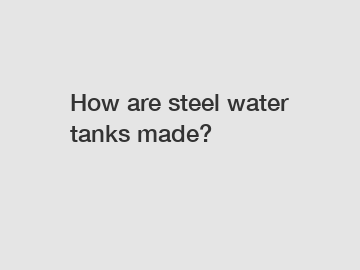How are steel water tanks made?
How are steel water tanks made?
Are you curious about the manufacturing process behind steel water tanks? Wonder no more! In this article, we will delve into the fascinating world of steel water tank fabrication. From the initial design to the final production stages, let's explore the creation of these essential structures.
1. Design and Planning:

The first step in making steel water tanks is the design and planning phase. Engineers carefully consider the tank's intended capacity, shape, and placement. Factors such as structural stability, water pressure, and environmental conditions are taken into account to ensure the tank's longevity and functionality. Once the specifications are finalized, the fabrication process can begin.
2. Material Selection:
After the design phase, the appropriate steel materials are selected. Steel is highly preferred for water tank construction due to its durability, strength, and resistance to corrosion. Typically, stainless steel or galvanized steel is chosen, depending on the application and budget. Stainless steel is more expensive but provides excellent corrosion resistance, while galvanized steel is a cost-effective alternative.
3. Cutting and Shaping:
Once the steel sheets are obtained, they are cut into the desired sizes using various tools such as plasma cutters or laser equipment. The sheets are then bent or rolled into the required shape for the tank components. This process allows for the creation of cylindrical, rectangular, or other custom shapes necessary for specific applications.
4. Welding and Joining:
Welding is a fundamental part of steel water tank fabrication. Pieces of steel are meticulously welded together using specialized techniques to form a watertight seal. Welding ensures structural integrity and prevents leaks, ensuring the tank can hold the intended volume of water securely. Advanced welding methods, such as robotic welding, are often employed to enhance precision and efficiency.
5. Coating and Finishing:
To protect steel water tanks from corrosion and external elements, a coating or finish is applied. The most common method is galvanization, where the steel components are hot-dipped in a layer of zinc. This zinc coating forms a barrier that prevents rusting and extends the lifespan of the tank. Additionally, a paint or epoxy finish may be added for aesthetic purposes or to provide further corrosion resistance.
6. Quality Control:
During the manufacturing process, rigorous quality control measures are implemented to ensure the tanks meet the required standards. Inspections are conducted at various stages, including material selection, welding, and finishing. Pressure tests are performed to check for leaks, and any necessary adjustments are made before the tanks are ready for distribution.
7. Installation:
Once the steel water tanks are fabricated and inspected, they are transported to their final destination for installation. Large tanks may be assembled on-site, while smaller tanks can be delivered as a complete unit. Proper installation is crucial to ensure the tank's stability and to avoid any potential hazards. Expert technicians oversee the installation process, ensuring all connections are secure and the tank is functioning optimally.
In conclusion, the process of making steel water tanks involves several crucial steps, from design and material selection to cutting, shaping, welding, and finishing. Each stage requires precision and careful attention to detail to produce durable and reliable tanks that meet industry standards. Whether used for residential, commercial, or industrial purposes, steel water tanks play a vital role in storing safe and clean water.
Want more information on lamella plate settlers, pvc vs plastic, tube settler supplier? Feel free to contact us.



Comments
0